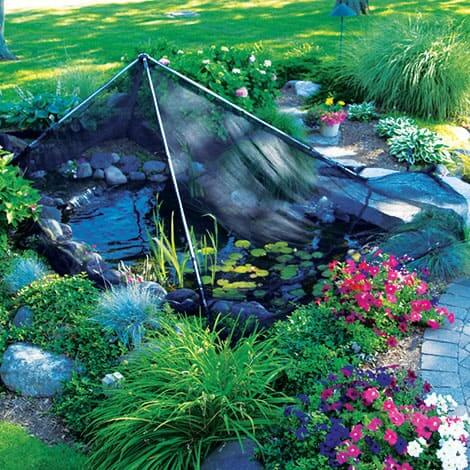Pond netting has many different applications. From preventing falling leaves or deterring predators, pond netting has you covered to keep things out.
Pond cover netting can be added as the season changes or used year-round. Make sure you clean leaves and debris off the netting often - a leaf blower makes quick work of that. If debris is left to accumulate, the netting could become weighted down and collapse into the pond. Not only will the leaves and debris end up in the pond, but your plants and fish may also die. Make sure to remove netting if there is a threat of ice and snow.
Low Profile Netting
If you are worried about pond cover netting blocking your view of the surrounding landscaping, use a flat piece of netting. Sections of netting can be staked down at the edges of the pond or just secured with rocks and other pond décor. The availability of different mesh sizes help in making sure you block out even the smallest leaves and pine needles.
- 5/8" Mesh Netting - Premium Protective Pond Netting is made of woven nylon, this 5/8" mesh netting is strong and durable. It is offered in sizes of 8' x 10' up to 30' x 30' and comes with an appropriate number of stakes.
- 1/8" Fine Mesh Netting - Premium Fine Mesh Pond Netting is made of small 1/8" mesh. This net for ponds will be sure to prevent even the tiniest pine needles from getting to the pond while still allowing light to get through. The Premium Fine Mesh Netting is available in three sizes and comes with stakes.
- 3/4" Economy Pond Netting – This 3/4" Mesh Polypropylene Netting is an affordable option for those looking to cover their water garden for a single season. It will deter predators and debris while still allowing you to view the pond. This netting does not come with stakes but they are available separately if needed.
Tented Netting
A tented design will make sure leaves and debris fall off instead of building up on top of the pond cover netting. Plants underneath will be safe from deer, rabbits and other veggie eaters. This style also helps to prevent plants from getting crushed should the netting become weighted down.
- PondShelter Net Kit, 16' x 11' – The four fully adjustable aluminum legs of this net kit allow it to cover anywhere between 4' x 6' to 16' x 11'. The PondShelter Net's 1/4" mesh netting keeps the leaves out and your aquatic life safe. It has a built-in drawstring at the bottom of the netting to hold in plants and the included stakes keep it anchored. Unlike other tented designs, this model can be used on flat or uneven landscaping.
- Pond & Garden Protector Net Kits – This fully framed net is movable in one piece for easy installation over the pond. Although it is not recommended for use on uneven ground, the 1/2" mesh netting will protect plants around the pond and can even be used in a garden setting. The net kit comes with plenty of extra netting around the base of the poles to ensure coverage and stakes for security.
- Big Top Pond Covers – The 1/4" mesh netting of the Big Top Pond Cover has a hemmed, fray resistant border. The three larger sizes have brass grommets in the top of the net that are held up by poles. Although available in larger sizes, the poles that hold this netting up are placed in the bottom of the pond. To easily clear debris from the net, remove the stakes from one side, lift the netting, and shake free any debris.
When to Use Pond Netting
Netting is a useful pond tool but can harm plants and fish if not used correctly. Every season has a different use for netting. Here are some tips for keeping your pond net and pond in top shape every season:
- Spring - Pond netting can be used in spring to help protect young plants from deer and rabbits. It will also deter herons, raccoons, or other predators from relying on your pond for meals. If a predator visits your pond a few times without catching a meal, they will quickly realize that they may never get one and it's time to try out a different fishing hole.
- Summer - Unless there is a big predator problem, most pond owners will remove pond netting in the summer. This allows you to enjoy the view unobstructed and to have easy access to the pond for fish feeding and maintenance.
- Fall - This is prime pond cover net season. When the leaves start changing color, pond owners know that they will eventually end up in the water. A large accumulation of debris at the bottom of the pond during winter can be detrimental to fish and the overall pond. Debris left in the water to decay over the winter adds ammonia to the water, causing stress to your fish.
- Winter - Pond netting should not be used in winter. Remove your pond nets when the last of the leaves have fallen, but before the first major winter storm. An accumulation of snow and ice on netting can cause it to collapse into the pond. Fish can get caught under heavy netting or the hole in the ice providing gas exchange may be compromised.
